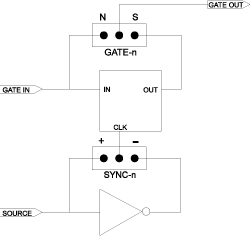CTR-05
ISA Bus Counter Timer Card
Features
- This product has been discontinued. Please contact us for help in finding a suitable replacement.
- Five independent 16-bit counters
- Input frequencies up to 7 MHz
- Up/Down and Binary or BCD modes
- Internal 1, 2 or 4 MHz counter clock source
- Programmed frequency output
- Tapped frequency output
- Complex duty cycle ouputs
- Alarm comparators on counters #1 and #2
- Synchronization of gate and clock inputs to provide improved timing accuracy
- Software drivers for Quickbasic, C, Pascal, and Windows
- Designed, made, supported, and manufactured in the USA

- event count accumulation
- stopwatch timing
- frequency-shift keying
- high-resolution baud rate generation
- complex pulse generation
- coincidence alarms
- time-of-day
- re-triggerable digital one-shots
- programmable duty-cycle waveforms
- programmable frequency synthesis
COUNTERS
Counters 1 and 2 have additional "alarm" registers and comparators associated with them plus logic for operating in a 24-hour time-of-day mode. For real-time applications, the time-of-day logic will accept 50 Hz, 60 Hz, or 100 Hz input frequencies. Each counter has a dedicated output pin. That output may be turned off when the output is not of interest. The 9513 chip provides considerable versatility for configuring inputs as well as gating of individual counters. This permits dynamic reassignment of inputs under softwar e control and also allows multiple counters to use a single input and allows a single gate input to control more than one counter.
The CTR-05 card includes flip-flops to synchronize gate and clock inputs and improve timing and counting accuracy. You can place jumpers to select either the synchronized or the non-synchronized mode. Further, a second jumper associated with each counter selects either leading edge or falling edge synchronization. Also, CTR-05 contains a means to assure that Read and Write pulses from the computer are at least 400 nS in duration. This feature is activated when a jumper is installed across two programming pins labeled WAIT. While normally not required, this feature is useful for computers with Bus speeds above 6-8 MHz.
CRYSTAL TIMEBASE
DIGITAL I/O
INTERRUPTS
Downloads
Available Reference Manuals
- View / Download the CTR-05 Manual (.PDF)
- View / Download the Software Reference Manual (.PDF)
Available Software Downloads
Drivers and Downloads
Full list of available Downloads: Software Packages, Drivers, Manuals, and other documents
Custom Software
ACCES also offers Custom Software Services for our products. Our prices are unbelievably low, often as inexpensive as free! If you need something tweaked to support your needs, or an entire enterprise application developed from scratch, it is definitely worth your time to inquire with us, first.
Further information about available ACCES Software:
- Redistributing Windows Drivers
- A list of ACCES drivers and the files that compose them under different versions of Windows, so you can easily redistribute ACCES cards and drivers.
Specifications

Counter Modes
Inputs
Outputs
Environmental
Power Requirements
Regulatory Compliance
- This product is in full compliance with CE requirements.
| Model | Price (USD) |
|---|---|
| CTR-05 | 178.00 |